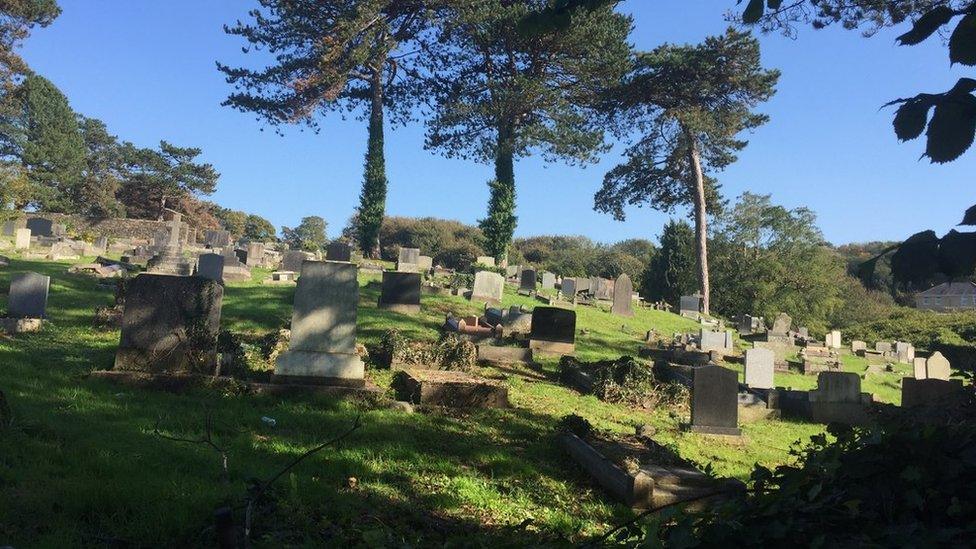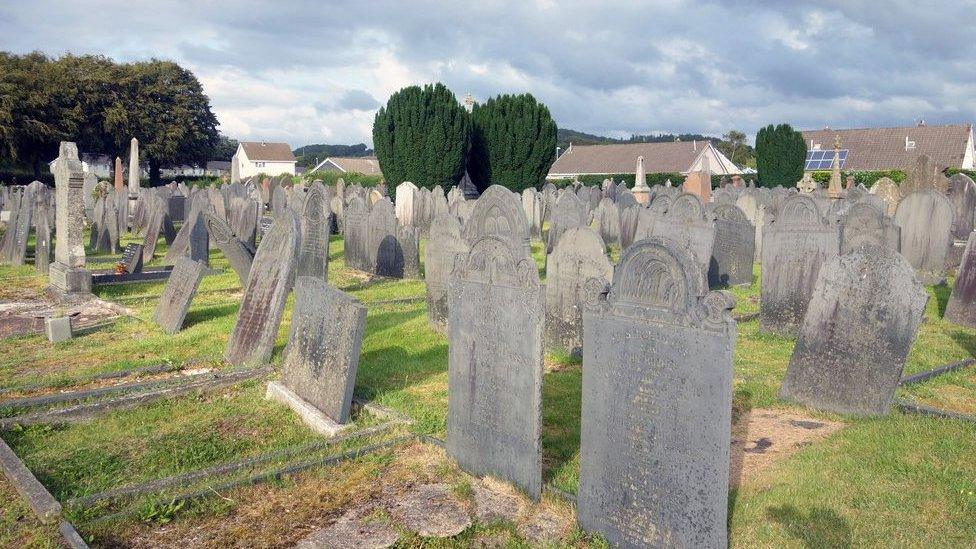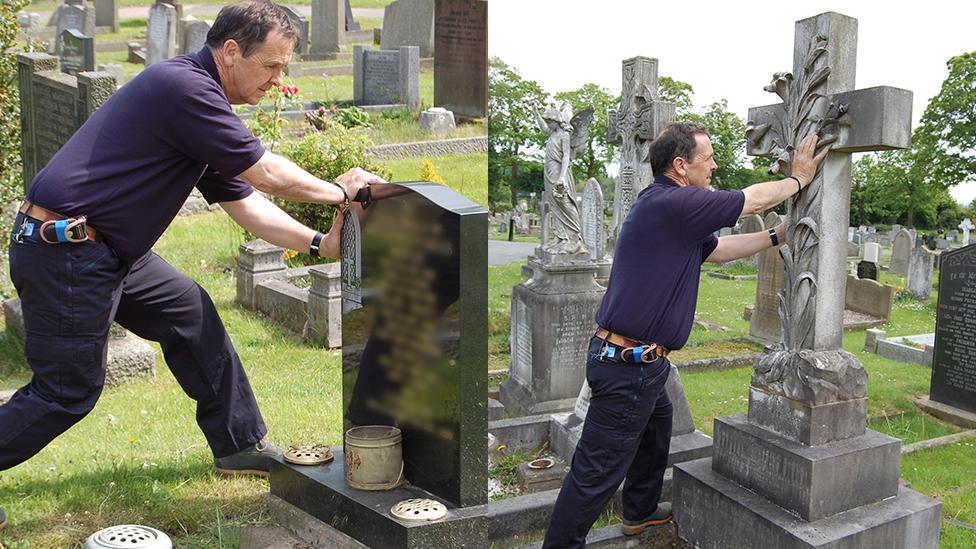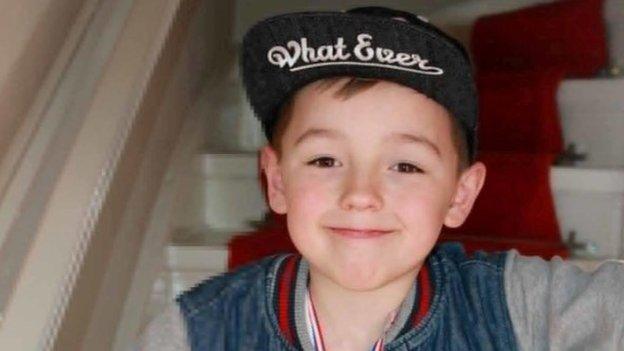Wales gravestones classed as 'unsafe' may be removed
- Published

An open day is being held at cemeteries including Llantwit, Neath, before a new policy is introduced
Gravestones and memorials across Wales could be removed and replaced if they do not meet safety standards.
While some councils already have policies in place, others are introducing new ones following the deaths of six people, including an eight-year-old boy from Glasgow, as a result of unsafe graves.
Neath Port Talbot is holding open days this week to answer any questions.
Councils usually try to contact owners or place notices before taking action.
Neath Port Talbot said it would be implementing the new policy later this month, and is holding open days in Margam and Llantwit on Monday and Carmel on Tuesday to answer questions.
It said it follows the deaths of six people across the UK in recent years, including eight-year-old Ciaran Williamson in 2015 who was crushed by a 7ft gravestone in Glasgow - and whose death could have been avoided if a regime of safety checks had been in place, a fatal accident inquiry found.

What is the picture across Wales?
Neath Port Talbot is responsible for nine cemeteries - Margam, Goytre, Cymmer, Ynysymaerdy, Llantwit, Onllwyn, Giants Grave, Carmel and Godrergraig.
It said it recognised the subject was "very emotive" but it has to balance the importance of dealing with families' needs sensitively with the need to maintain a safe environment at its cemeteries.
In the first instance, unsafe memorials will be "stake and banded", the council said - a wooden stake placed at the back of the memorial then, using nylon strapping, the memorial is banded to this stake.
Other options include re-laying horizontally or having the headstone lowered into the ground to make it firmer.
Powys council said it too would be carrying out inspections at its cemetery in Machynlleth this year, checking memorials larger than 1.5m (5ft) to make sure they are not at risk of falling and injuring someone.
"Specialist staff will be carrying out inspections and any memorial that is identified as dangerous will be made safe by laying it down," a spokesman said.
"We appreciate that memorials are a sensitive subject but we have to be sure that our cemeteries are a safe place to visit and any that are potentially dangerous will be made safe."
Caerphilly's draft budget, however, talks about a further reduction in the cemeteries budget "which has been cut in successive years".
"This will reduce the ability to improve or repair cemetery infrastructure," the report says.
The council inspects memorials every four years and does not remove any, laying them flat if owners cannot be contacted.

Inspections will be carried out at the cemetery in Machynlleth
Torfaen said it did not know how many were considered unsafe but "due to the number of old memorials it is likely to be an issue" with gravestones becoming loose from the ground and likely to fall over. Its cemeteries manager is looking to update and implement an historic policy.
In Gwynedd unsafe memorials are a "recognised risk" with issues such as structural degradation, component failure and poor standard of erection, with regular inspections and action taken.
Flintshire inspects its 15 cemeteries every three years - with just 15 of the 7,500 memorials requiring action last year and Rhondda Cynon Taf is currently checking 76,000 memorials in its 14 cemeteries for safety, saying it appreciates "how emotive these subjects can be".
Pembrokeshire council, responsible for 11 cemeteries, said memorials have been "wrongly assumed to be permanent structures that have been installed to the highest standard and will last forever without any need for repair" but unsafe structures had caused deaths.
In its policy, the council said guidelines were developed but "some authorities were subject to considerable criticism, public concern was also raised about the methodology employed by some authorities".
Pembrokeshire inspects the cemeteries every five years, sending letters to owners of unsafe structures where possible and laying down the grave or making it safe if it poses a serious risk.
Conwy council is also currently reviewing and updating its cemeteries policy, and Ceredigion said its approach is also subject to review.
Carmarthenshire council tested all its memorials at Ammanford for safety and reinstated unsafe headstones in 2004, and continues to inspect annually and Monmouthshire said it has never had an issue - but has a policy to deal with any unsafe structures.
Wrexham said its staff were trained to carry out testing, and any deemed unsafe are laid flat on the ground while it looks for a living grave owner and Cardiff council has had a scheme in place for about 20 years, inspecting every five years with a "very low" failure rate as a result of the checks being ongoing for so long, it said.
Newport council sinks graves to the ground, lays them flat, cordons them off or stake and bands them if unsafe, inspecting its cemeteries every five years. It gives grave owners 28 days to come forward if a memorial needs to be removed.

One town council was criticised after headstones were covered in yellow plastic
Denbighshire said it does not remove unsafe gravestones, and as a result lays memorials flat - saying memorial safety is an issue for all authorities.
On Anglesey, gravestones at St Cybi, Holyhead, have been laid flat for many years. The other cemeteries on the island are the responsibility of town and community councils.
Similarly the Vale of Glamorgan council is not responsible for any graveyards or burial sites.
Swansea council said it has had a rolling programme of inspections "for many years".
It said that any memorials which appear to be in a potentially unstable or hazardous condition are laid down or the family is contacted and they arrange a mason to carry out repairs.
Merthyr tests its memorials every five years, laying flat or stake and banding any deemed unsafe and informing the owners.
All our memorials are tested on a five year schedule by a dedicated memorial inspector. They are inspected to the NAMM Code of Working Practice and BS 8415 using specialised equipment. If deemed unsafe they are either laid flat or staked and banded and the owners informed.
Blaenau Gwent and Bridgend did not respond to the BBC's request for information.
In July 2019, Cowbridge council was criticised for wrapping headstones deemed dangerous in yellow plastic which one family said looked "like a crime scene".
The bags were marked with the words, "danger", "unsafe" and "keep away" and bore a message: "Please contact the cemetery office," with red and white tape wrapped round them.
Cowbridge Mayor Alec Trousdell said the council regretted the stress caused and would find another way of marking memorials carrying a risk.
How do councils test memorials' safety?

Contractors test the safety of headstones and monuments for Pembrokeshire council

Workers are told to be aware of headstones or memorials made up of more than one section and examine the top section first and work down, to avoid injuring themselves, according to Pembrokeshire's guidelines.
A hand test is carried out standing in front, but to one side of the headstone and gentle pressure is applied until a force of about 25kg (250 Newtons) is applied, and then repeated on the back of the memorial.
It should only fail if it continues to move until it falls to the ground, the guidelines say.
If it does fail, a mechanical measuring device is used to confirm at which force - though the mechanical device is not suitable for memorials taller than 1.5m.
Extra risk factors include memorials near main paths, well-visited areas, ones that attract anti-social behaviour, ones on sloping or uneven ground, areas with many large multi-part memorials or badly weathered ones. Newer memorials usually meet modern standards.
- Published25 January 2018

- Published12 July 2019
